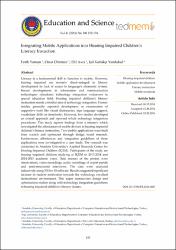| dc.contributor.author | Yaman, Fatih | |
| dc.contributor.author | Dönmez, Onur | |
| dc.contributor.author | Avcı, Elif | |
| dc.contributor.author | Kabakçı Yurdakul, Işıl | |
| dc.date.accessioned | 2019-10-19T17:27:45Z | |
| dc.date.available | 2019-10-19T17:27:45Z | |
| dc.date.issued | 2016 | |
| dc.identifier.issn | 1300-1337 | |
| dc.identifier.uri | https://dx.doi.org/10.15390/EB.2016.6687 | |
| dc.identifier.uri | https://hdl.handle.net/11421/14665 | |
| dc.description | WOS: 000391649700009 | en_US |
| dc.description.abstract | Literacy is a fundamental skill to function in society. However, hearing impaired are severely disadvantaged in literacy development by lack of access to language's phonemic system. Recent developments in information and communication technologies stimulated technology integration endeavors in special education field. Hearing impaired children's literacy instruction stands a fruitful area of technology integration. Former studies generally reported development or examination of supportive tools like visual dictionaries, sign language support, vocabulary drills or storybooks. However, few studies developed an overall approach and reported whole technology integration procedures. This study reports findings from a research which investigated the affordances of mobile devices in hearing impaired children's literacy instruction. Two mobile applications were built from scratch and optimized through design based research. Furthermore, affordances and integration guidelines of these applications were investigated in a case study. The research was conducted in Anadolu University's Applied Research Center for Hearing Impaired Children (ICEM). Participants of the study are hearing impaired children studying at IcEM in 2013-2014 and 2014-2015 academic years. Data sources of the project were observations, video recordings, audio recordings of expert panels and semi-structured interviews. The data were analyzed inductively using NVivo 10 software. Results suggested significant increase in student motivation towards the technology enriched instructional environment. This paper summarizes design and optimization studies along with technology integration guidelines to hearing impaired children's literacy classes. | en_US |
| dc.language.iso | eng | en_US |
| dc.publisher | Turkish Education Assoc | en_US |
| dc.relation.isversionof | 10.15390/EB.2016.6687 | en_US |
| dc.rights | info:eu-repo/semantics/openAccess | en_US |
| dc.subject | Hearing-Impaired Children | en_US |
| dc.subject | Mobile Application Development | en_US |
| dc.subject | Literacy Instruction | en_US |
| dc.subject | Mobile Storybook | en_US |
| dc.title | Integrating Mobile Applications into Hearing Impaired Children's Literacy Instuction | en_US |
| dc.type | article | en_US |
| dc.relation.journal | Eğitim ve Bilim-Education and Science | en_US |
| dc.contributor.department | Anadolu Üniversitesi, Eğitim Fakültesi, Bilgisayar ve Öğretim Teknolojileri Eğitimi Bölümü | en_US |
| dc.identifier.volume | 41 | en_US |
| dc.identifier.issue | 188 | en_US |
| dc.identifier.startpage | 153 | en_US |
| dc.identifier.endpage | 174 | en_US |
| dc.relation.publicationcategory | Makale - Uluslararası Hakemli Dergi - Kurum Öğretim Elemanı | en_US] |
| dc.contributor.institutionauthor | Kabakçı Yurdakul, Işıl | |


















